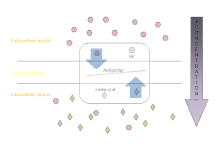Structural Biochemistry/Membrane Proteins/Antiporters
Antiporters[edit | edit source]
An antiporter is an integral protein involved in secondary active transport, which couples the energy of a molecule moving down its concentration gradient to another moving up its concentration gradient. The antiporter simultaneously transports two molecules at the same time in the opposite direction.
Antiporter, also called exchanger and counter-transporter, is an integral membrane protein that involves in a secondary active transporter of two or more different substrates (molecules or ions). These substrates are pumped in opposite directions across a membrane. It is a channel that transports different types of substrates across a phospholipid membrane (one into the cell and one out of the cell) either simultaneously or sequentially.

In secondary active transport, species of solute moves along its electrochemical gradient which allows other different species to move against its own electrochemical gradient. There are two main forms of secondary active transport, antiporters and symporters.

ATP-ADP Translocase
ATP-ADP translocase is one type of antiporter that assist in oxidative phosphorylation, a key component of cellular respiration in eukaryotic cells. This specific transport protein is located in the inner mitochondrial membrane that allows ATP and ADP to be transported across the membrane since ATP and ADP cannot diffuse across the inner mitochondrial membrane by itself. ATP-ADP translocase is in high abundance and it makes up about 15% of the protein content in the inner mitochondrial membrane. The high abundance of ATP-ADP translocase can be attributed to the fact that homo sapiens exchange ATP in very large amounts. In addition, this flow of ATP and ADP are coupled in that ADP can only enter the mitochondrial matrix if ATP exits (vice versa). This means that the translocase catalyzes the couples the entry and exit of ADP and ATP respectively from the matrix. This process is represented by the equation:
ADP3-cytoplasm + ATP4-matrix → ADP3-matrix + ATP4-cytoplasm
ATP-ADP translocase is about 30 kilodaltons in size and has a single nucleotide binding site that has the orientation facing the matrix side and the side of the cytoplasm of the membrane. ATP and ADP can bind to the translocase without the help of Mg2+, and since ATP has an additional negative charge than ADP (see equation above) the ATP transport out of the mitochondrial matrix and ADP transport into the matrix is favored for a mitochondrion with a positive membrane potential that is actively respiring. As soon as ADP binds from the cytoplasm, the transporter favors the configuration that will invert the transporter to release ADP into the matrix. The ensuing binding of ATP from the matrix to the inverted configuration favors the inversion of the translocase back to original configuration in which ATP is released into the cytoplasm (See Figure Below). However, the ATP-ADP exchange is still endothermic and requires about 25% of the energy yielded from electron transfer of respiration to be consumed in order to restore the membrane potential.
Analysis of the primary structure (amino acid sequence) of ATP-ADP translocase revealed that this protein is made up of three sequence repeats of length of 100 amino acids, in which each has two transmembrane segments. The structures of the three sequence repeats have been determined from three dimensional structure of this transporter. The three transmembrane helices form a conical structure that come together to form the binding site of the nucleotide in the center of the cone-like structure.